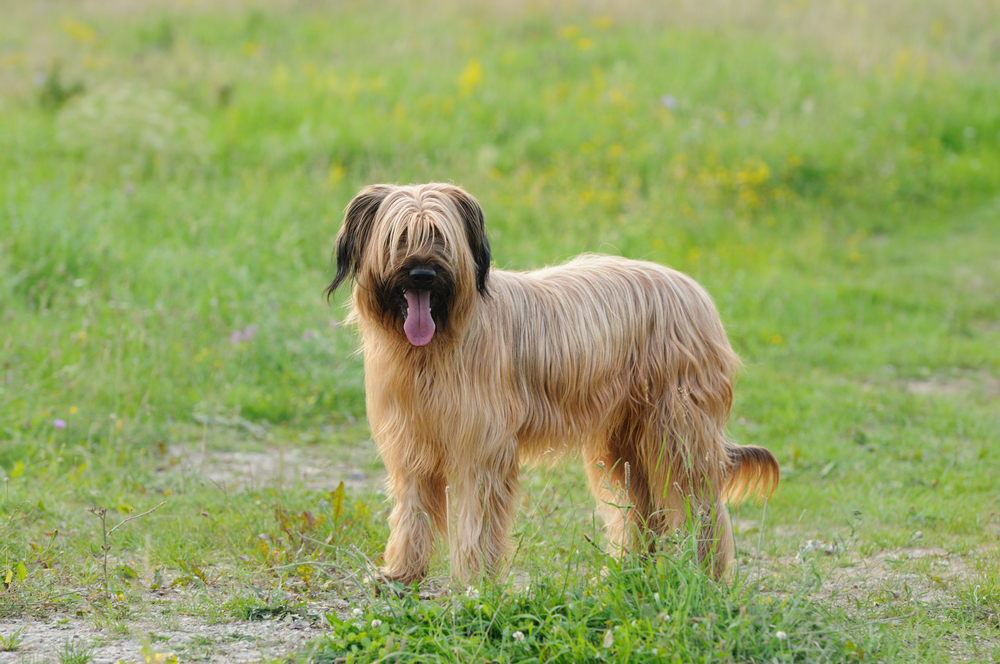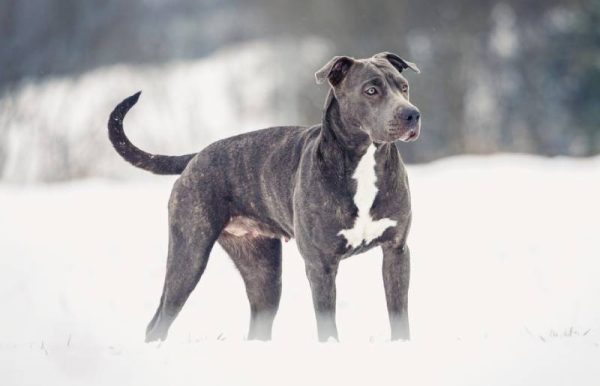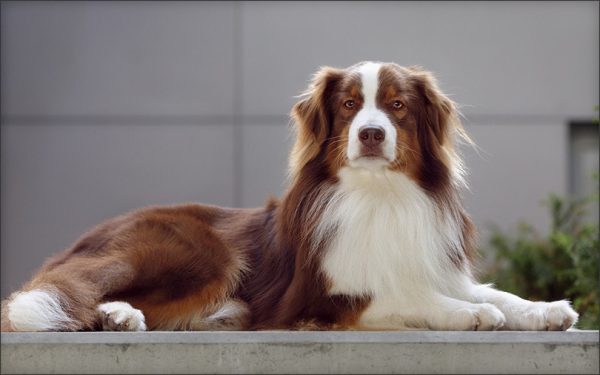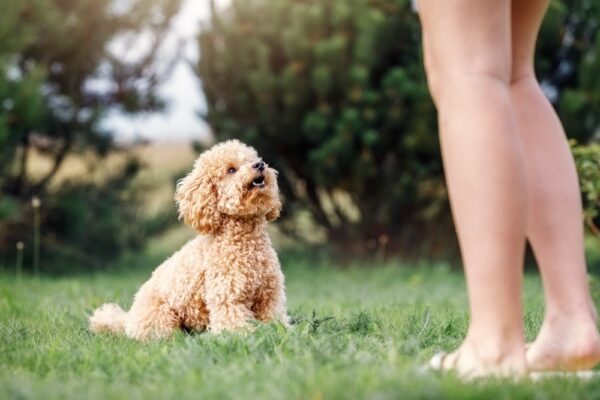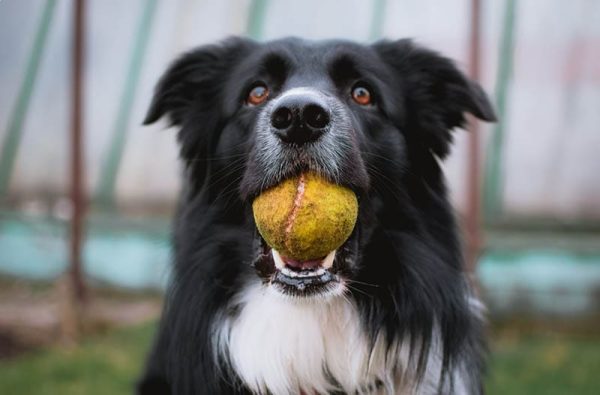In this article
View 8 More +The Briard (Chien Berger de Brie) is a large, loveable, and shaggy sheepdog native to France. Named after the historic region of Brie where the famous cheese is produced, the Briard has been around since the 8th century and was developed to perform general farm tasks in addition to herding and watching over sheep.
Imbued with a protective instinct that has been retained to this day, the Briard also made it his business to guard and be a devoted companion to his human family when the day’s work was done. Without further ado, let’s take a closer look at this dutiful, courageous, and faithful dog.
Breed Overview
Height:
22–27 inches
Weight:
55–100 pounds
Lifespan:
12 years
Colors:
Black, tawny, gray, black & gray, black & tawny, white, tawny & gray
Suitable for:
Active, loving caregivers committed to training and socialization
Temperament:
Loving, quick to learn, gentle, self-assured, courageous
Breed enthusiasts often describe the Briard as a “heart wrapped in fur”, a testament to this dog’s companionability, loyalty, gentle nature, and, of course, that show-stopping coat. Don’t take that to mean the Briard is a pushover—far from it.
This rugged pooch’s herding instincts and inclination to think for itself remain untouched, so there’s a healthy dose of independence and self-confidence to go with all that sweetness.
Briard Characteristics

Briard Puppies
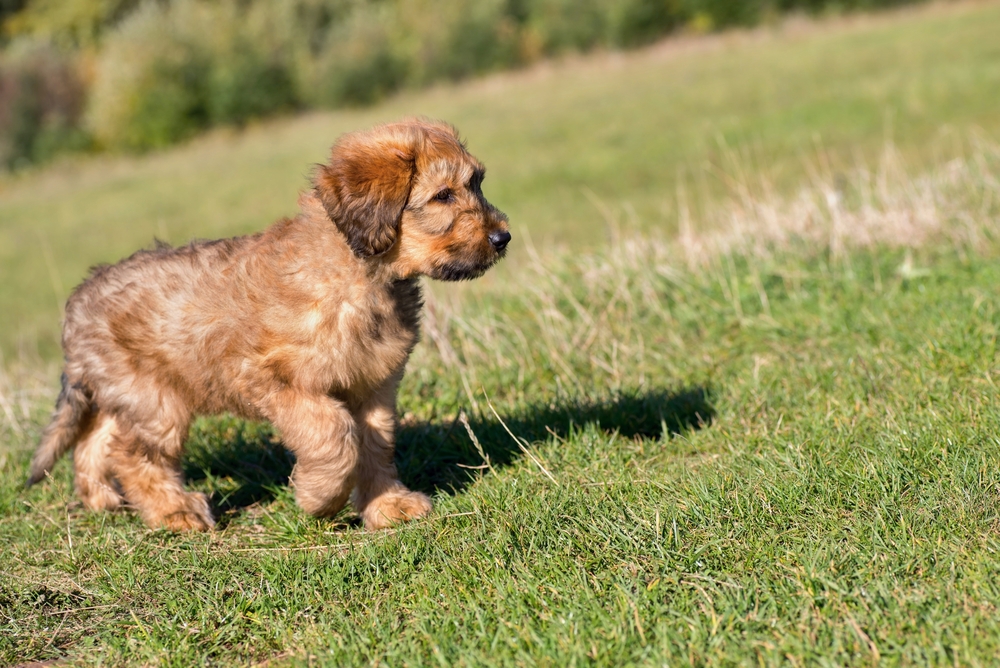
While not among the most popular dog breeds in the United States (the Briard sits at 151 out of 201 on the American Kennel Club’s popularity ranking), finding reputable Briard breeders shouldn’t be too difficult. However, there is an alternative—Briard adoption.
There are charities and organizations out there dedicated to rehoming Briards and Briard mixes, so this avenue is well worth checking out. You may not find a Briard puppy via this route (you never know), but adoption is a much less costly option and turns a dog in need’s whole life around.
If you do bring home a Briard puppy, get a head start on training and socializing them as this will stand you in good stead later on. Briards are famous for possessing a stubborn streak when it comes to training, so the earlier you instill good habits, the better.

Temperament & Intelligence of the Briard 🧠
Briards are well-balanced dogs that love their people unconditionally but are usually independent enough to not be too bothered by spending a healthy amount of time alone while you go to work or run daily errands.
The Briard’s self-assuredness and independence come from their past as herding dogs; on farms and pastures, these dogs were expected to be able to think for themselves and face a variety of situations with confidence. Nevertheless, it’s still important to build positive associations around alone time, as is the case for every type of dog.
In addition to being loving yet independent, the Briard is an intelligent and playful dog. Briards can also be a little wary of strangers due to their natural protectiveness, so it’s important to socialize them with people outside the family home and other dogs.
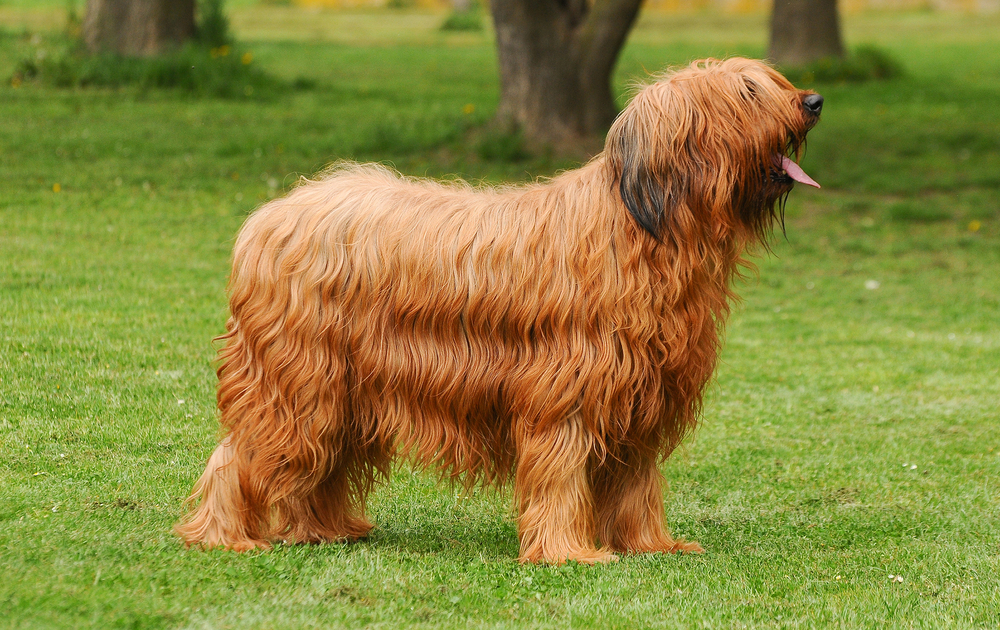
Are These Dogs Good for Families? 🏡
Yes, Briards are great family dogs thanks to their gentle nature and sense of fun. However, socialization and training are very important to keep their natural herding instincts in check. While Briards are typically gentle with children, they may perceive them as something to herd during play (herding dogs’ instincts are triggered by movement) and get a little bossy with them.
It’s wise to train your Briard to “leave it” or teach a focus command like “watch me” to redirect this kind of behavior should it happen. You can also require your Briard to display calm behavior before getting something exciting to teach them a sense of self-control. For example, before throwing a ball, ask your dog to sit.
Does This Breed Get Along with Other Pets? 🐶 😽
Yes, though the Briard has an independent streak, these dogs often get along well with other dogs and cats in the household. Of course, this depends on whether or not they’ve been socialized around other animals.
When you bring your new dog home, work on forging positive associations around the new dog for your other pets and vice versa. Let them meet from a distance and under close supervision before you unleash them around one another. Like with kids, herding dogs may get into the habit of trying to herd their fluffy housemates, so keep an eye on that.

Things to Know When Owning a Briard
Food & Diet Requirements 🦴
When it comes to picking a dog food formula, it’s best to go for the highest quality within your budget range. Complete and balanced commercially available formulas are ideal because they’re made to fulfill all of a dog’s nutritional needs. Making your own dog food is hard to get right nutritionally, so only do this under veterinary supervision.
Different dogs need different kinds of formulas depending on age, weight, and health, so check the packaging carefully. If your dog has a health condition, work with your vet to decide on the best kind of diet.
Be careful not to feed too many treats when training your Briard as this could lead to weight gain, and research which kinds of human foods are unsafe for canines (garlic, onions, and chocolate are but a few of the foods toxic to dogs) so you can make sure your dog stays away from them.
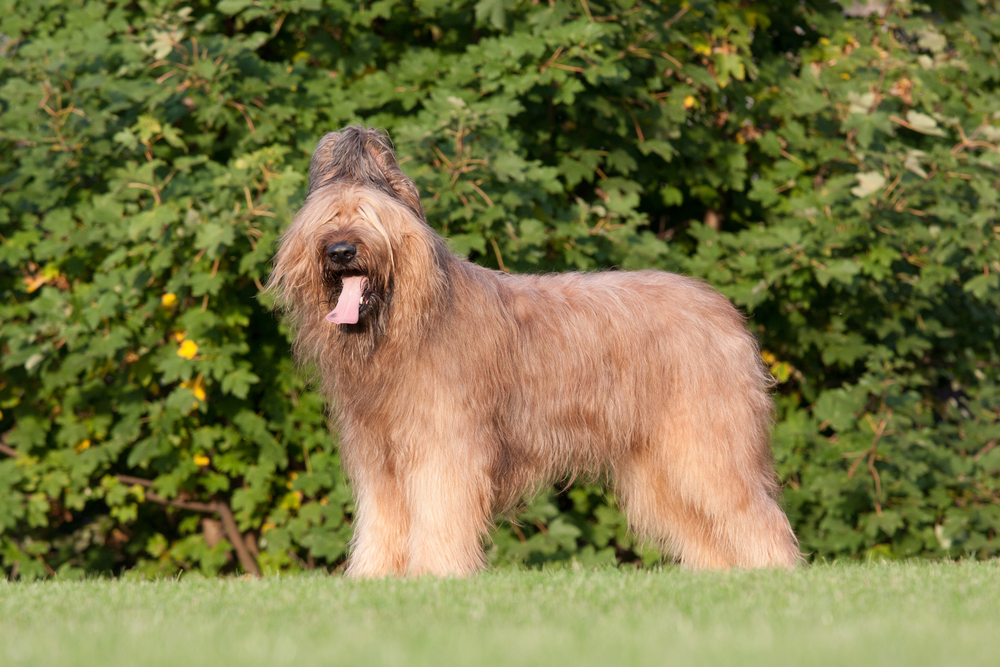
Exercise 🐕
Briards are active dogs that must have a daily outlet for their energy. In addition to walking your Briard and engaging in interactive play, you can also give these work-happy dogs little jobs to do to keep them busy.
This may include giving your Briard something to carry around the house, teaching them to close doors, or training them to put things away. These things may require a bit of patience to teach, but Briards are smart and learn quickly.
Training 🦮
On one hand, Briards are very trainable because they learn fast and have a strong work ethic. On the other hand, the famous stubborn streak they possess can make training a challenge if you lack consistency or training sessions become boring or too long-winded.
This breed needs plenty of positive reinforcement and short (around 10–15 minutes each), upbeat training sessions with motivators depending on what your dog likes most. Different dogs appreciate different motivators, so get to know what your Briard is most fond of, whether that be treats, toys, or abundant praise.
Grooming ✂️
Even when they’re puppies and their shaggy coat isn’t very long yet, you’ll want to start brushing them early to get them used to it. Though not heavy shedders, Briards need to be thoroughly brushed daily or at least every few days to keep their coat free of tangles and mats.
As for bathing, unless your Briard often gets dirty, you’ll only need to do this every now and again. If you bathe your Briard on a regular basis, be mindful not to do it so often that you strip the coat’s natural oils as this does more harm than good. Some Briards get away with a bath every few months whereas others may need a weekly bath.
Other grooming tasks for your Briard include brushing their teeth every day and trimming the nails when needed to make sure they don’t become uncomfortable.
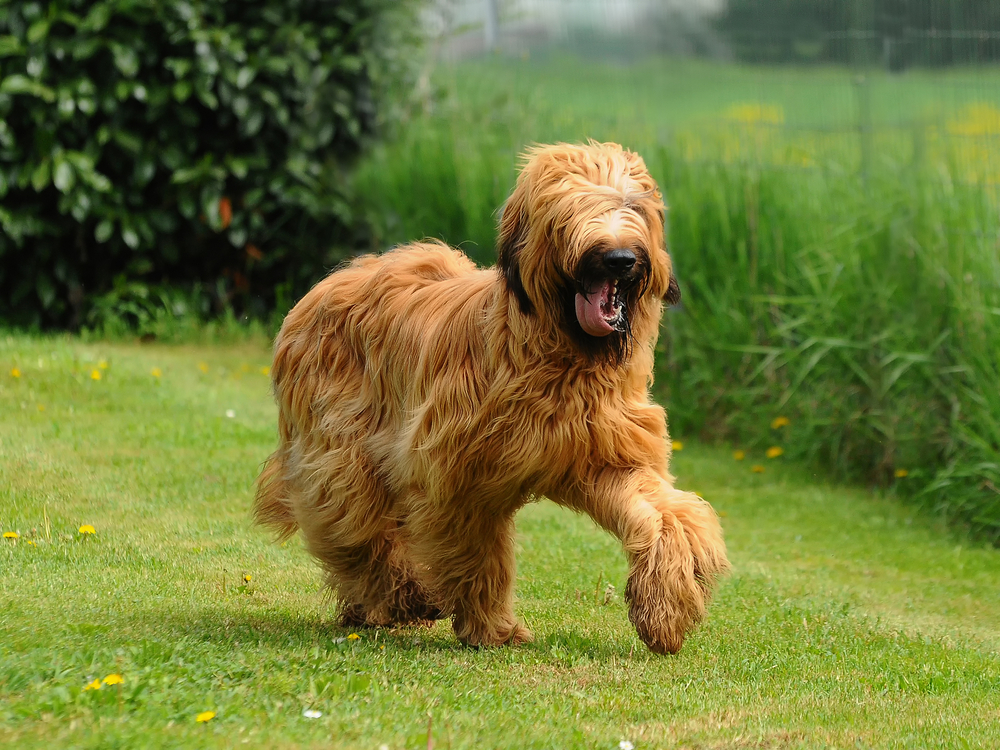
Health and Conditions ❤️
Every dog breed has certain genetic health conditions associated with it, and the Briard is no exception. That doesn’t mean your dog will definitely develop a health condition, but it does mean you have to be vigilant for signs that something isn’t right, just in case.
Gastric torsion (bloat) is an example of a condition that’s been linked mostly to large breeds, including the Briard. While in humans, bloat is often viewed as a common, harmless occurrence, in dogs, it’s very serious because the stomach twists to the point where its entry and exit points are blocked. It can be fatal if not treated immediately. Other conditions that may affect the Briard include:
- Mild night blindness
- Hip dysplasia
- Heart conditions
- Eye conditions like progressive retinal atrophy
- Hypothyroidism
- Kidney disease
- Von Willebrand’s disease

Male vs Female
We suggest getting to know a dog as much as possible before you bring them home, so you get an idea of their personality and whether or not you’ll be a good match for one another. Choosing a dog based only on gender is not a good determiner of personality and suitability because every dog is unique.
You might want to consider having your Briard neutered (male) or spayed (female) when they’re old enough to help reduce hormone-related behaviors like urine marking, roaming, and aggression toward other males (unneutered males) or irritability and frequent urination (unspayed females) during the heat cycle.
Spaying and neutering also prevent unwanted pregnancies and reduce the risk of health issues like testicular cancer and prostate cancer in males and uterine and ovarian cancer in females.
3 Little-Known Facts About the Briard
1. The Briard Has Appeared in Ancient Tapestries
Dogs that look similar to today’s Briard can be seen in tapestries from the 8th century. These tapestries date back to the reign of Charlemagne (742–814).
2. Briards Have Worked During the World Wars
The Briards aided the French army in both WWI and WWII in a variety of ways. Their jobs included delivering supplies to the front line and tracking down soldiers in need of medical attention. Sadly, many Briards lost their lives while on duty and these dogs aren’t as easy to come across these days as a result of that.
3. Briards Move in a Special Way
A notable Briard trait is the way these dogs move. The American Kennel Club describes their movements as if they are “gliding over the ground”, more like a cat than a dog. This may surprise some given how large and rugged Briards are.

Conclusion
Briards are big dogs with big hearts to match, but they’re not for everyone. First-time owners may find these loving and loyal but independent-minded, energetic dogs a bit of a challenge to train. However, if you’re committed to socializing and training your Briard well, you’re sure to reap plenty of rewards in parenting one of these lovely canines.
Featured Image Credit: Lenkadan, Shutterstock
